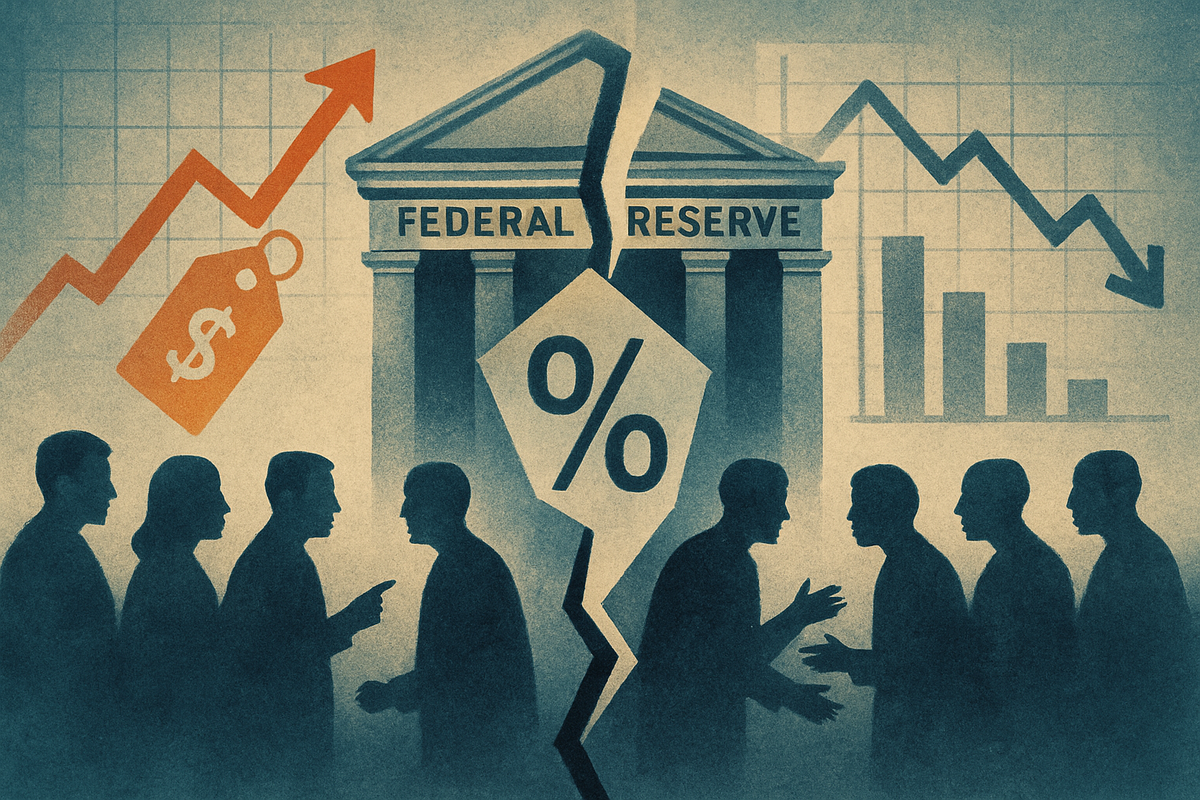
The Federal Reserve finds itself navigating a treacherous economic landscape, where conflicting data points on inflation and employment are stoking profound divisions among its policymakers. This internal discord is creating significant uncertainty regarding the future trajectory of interest rates, leaving financial markets and businesses on edge as the central bank grapples with its dual mandate of achieving maximum employment and stable prices. The immediate implications include heightened market volatility and a challenging environment for clear monetary policy communication, as officials openly debate the appropriate response to an economy sending mixed signals.
At the heart of the debate is how to interpret a complex economic picture: inflation, while showing some moderation, remains stubbornly above the Fed's 2% target, even as the labor market exhibits clear signs of cooling. This delicate balancing act is forcing policymakers to weigh the risks of cutting rates too aggressively and reigniting price pressures against the dangers of maintaining restrictive policy for too long and triggering an economic downturn. The outcome of these internal deliberations will have far-reaching consequences for borrowing costs, investment, and the overall health of the U.S. economy.
A House Divided: The Fed's Battle Over Monetary Policy
The divisions within the Federal Open Market Committee (FOMC) became acutely apparent following the September 2025 meeting, where the Fed enacted a 25-basis-point rate cut, bringing the federal funds rate to a target range of 4.00% to 4.25%. This move, the first rate reduction of the year, was notably not unanimous, underscoring the deep ideological rifts among officials.
Leading the charge for more aggressive easing is Fed Governor Stephen Miran, who dissented in September, advocating for a more substantial 50-basis-point cut and arguing for further swift reductions. Miran contends that current monetary policy is "very restrictive" and that moderating inflation necessitates sharper cuts to bolster job growth. Conversely, officials such as Minneapolis Fed President Neel Kashkari and Kansas City Fed President Jeffrey Schmid have voiced strong caution, warning that premature or overly aggressive rate cuts could lead to a resurgence of inflation or cause it to remain "sticky" near current elevated levels. Atlanta Fed President Raphael Bostic also favors a more measured, gradual approach to easing.
The internal split is stark: after the September cut, 10 out of 19 senior Fed officials projected support for two additional rate cuts by the end of 2025, while the remaining nine favored only one cut or none at all. This "house divided" scenario is further complicated by recent economic data. The annual inflation rate for the U.S. stood at 2.9% for the 12 months ending August 2025, a slight uptick from 2.7% previously, persistently above the Fed's target. Core CPI also rose by 3.1% over the same period, and consumer inflation expectations have climbed. On the employment front, however, signals point to a cooling trend: U.S. nonfarm payrolls increased by a modest 22,000 in August 2025, significantly below expectations, and the unemployment rate rose to 4.3% in August, its highest since October 2021. This deterioration in the labor market has particularly concerned officials like Governor Lisa Cook and San Francisco Fed President Mary Daly. Adding to the complexity, a government shutdown in October 2025 has delayed crucial economic reports, including the September employment survey, creating a "data blackout" that further obscures the economic picture and exacerbates policymaking challenges.
Initial market reactions reflect this uncertainty, yet also a prevailing "Fed Cut Fever." Despite the internal debates and data ambiguity, many analysts predict another 25-basis-point cut at the upcoming October FOMC meeting and potentially another in December 2025. This anticipation has fueled a "risk-on" sentiment, pushing major U.S. stock indices to new highs, as investors bet on continued monetary easing. However, this bullishness coexists with underlying nervousness, as mixed messages from Fed officials can lead to sudden fluctuations in bond yields and choppy stock market performance, limiting long-term risk appetite for some.
Corporate Fortunes Tied to the Fed's Next Move
The Federal Reserve's internal divisions and the resulting uncertainty over interest rates create a bifurcated environment for public companies, where some sectors stand to gain while others face significant headwinds. The ultimate path of monetary policy—whether the Fed leans towards more cuts or maintains a cautious stance—will determine the winners and losers in the coming months.
Companies in rate-sensitive sectors, particularly housing and automotive, are poised to benefit significantly from aggressive rate cuts. Lower interest rates translate directly into cheaper mortgages and auto loans, stimulating consumer demand for big-ticket purchases. Homebuilders like D.R. Horton (NYSE: DHI) and Lennar (NYSE: LEN) could see increased sales and order backlogs, while automotive manufacturers such as General Motors (NYSE: GM) and Ford (NYSE: F) might experience a boost in vehicle financing and demand. Similarly, consumer discretionary companies, which thrive on robust consumer spending, could see improved performance.
Conversely, a more hawkish stance from the Fed, or even a prolonged period of uncertainty, would pressure these same sectors. Higher borrowing costs would dampen consumer enthusiasm for large purchases, impacting sales and profitability. The financial sector, particularly regional banks like KeyCorp (NYSE: KEY) or Truist Financial (NYSE: TFC), often benefits from higher interest rates, as it allows them to earn more on their lending activities. However, if rates remain elevated for too long, leading to an economic slowdown, loan defaults could rise, offsetting the benefits of wider net interest margins. Investment banks and asset managers, such as Goldman Sachs (NYSE: GS), might also face reduced deal activity and asset inflows if market uncertainty persists and economic growth falters.
Technology companies, particularly those reliant on future growth projections and venture capital funding, like early-stage biotech firms or high-growth software companies, are often sensitive to interest rates. Lower rates can make their future earnings more attractive in present value terms and reduce the cost of capital for expansion. Giants like Microsoft (NASDAQ: MSFT) and Apple (NASDAQ: AAPL), while less sensitive due to their robust cash flows, still benefit from a generally growth-supportive, lower-rate environment that encourages consumer and business spending on their products and services. However, if rates remain high or increase, it can raise the cost of capital, potentially impacting valuations and investment decisions across the tech landscape.
Wider Significance: A Precedent for Policy Paralysis?
The current divisions within the Federal Reserve over interest rate policy are more than just an internal disagreement; they represent a significant challenge to the institution's credibility and its ability to effectively steer the economy. This event fits into broader economic trends characterized by persistent inflationary pressures juxtaposed with a decelerating labor market—a scenario often referred to as stagflationary fears. The Fed's dual mandate, designed to balance employment and price stability, is being tested like never before, forcing policymakers to prioritize one objective over the other, or attempt a precarious middle ground.
The potential ripple effects extend beyond direct interest rate impacts. Protracted uncertainty from the Fed could lead to a "wait-and-see" approach from businesses, delaying capital expenditures, hiring, and expansion plans. This caution could further slow economic growth, creating a self-fulfilling prophecy of stagnation. Competitors and partners in global markets are also watching closely; a volatile U.S. monetary policy could lead to currency fluctuations and impact international trade flows, especially for companies with significant global operations or supply chains. For instance, multinational corporations like Coca-Cola (NYSE: KO) or Procter & Gamble (NYSE: PG) could see their international earnings affected by a stronger or weaker dollar driven by Fed policy.
Regulatory and policy implications are also substantial. The public scrutiny of the Fed's decision-making process intensifies when there are clear internal divisions. This could lead to calls for greater transparency or even legislative oversight, potentially undermining the central bank's independence. The delay in critical economic data due to the government shutdown further complicates this, as policymakers are forced to make decisions with an incomplete picture, raising questions about data reliability and policy efficacy.
Historically, the Federal Reserve has experienced periods of internal disagreement, particularly during times of economic transition or crisis. For example, during the early 1980s, under Chairman Paul Volcker, there were debates about the severity of interest rate hikes needed to combat rampant inflation, ultimately leading to a recession but successfully taming price increases. More recently, during the post-2008 financial crisis recovery, there were debates about the timing and pace of quantitative easing tapering. While dissent is a natural part of a robust policymaking body, prolonged and public divisions risk eroding market confidence and making the Fed's forward guidance less effective. The current situation, with mixed signals on both sides of the dual mandate, presents a unique challenge that draws parallels to these historical periods of significant policy uncertainty.
What Comes Next: Navigating the Fog of Economic Signals
The immediate future for interest rates and the broader economy remains shrouded in uncertainty, largely due to the Federal Reserve's internal divisions and the conflicting economic data. In the short term, market participants are keenly awaiting the next FOMC meeting, with many anticipating another 25-basis-point rate cut, potentially in late October or December 2025. This expectation is driving a "risk-on" sentiment in equity markets, but any deviation from this anticipated path could trigger significant market volatility. Businesses should prepare for continued fluctuations in borrowing costs and a potentially uneven economic recovery.
Looking further ahead, several scenarios could unfold. One possibility is a "soft landing," where the Fed successfully navigates the complex data, implements measured rate cuts, and inflation gradually returns to target without triggering a severe recession. In this scenario, the labor market would cool sufficiently to ease wage pressures but avoid a sharp rise in unemployment. This outcome would likely support a sustained, albeit modest, economic expansion, favoring growth-oriented companies and a gradual recovery in rate-sensitive sectors.
Alternatively, the Fed's internal divisions could lead to policy missteps. If the Fed cuts rates too quickly in response to weakening employment, inflation could reaccelerate, forcing the central bank to reverse course with future hikes—a "stop-go" policy that historically creates instability. Conversely, if the Fed maintains a restrictive stance for too long, prioritizing inflation containment over employment, it risks pushing the economy into a deeper recession. In this scenario, defensive sectors like utilities, consumer staples, and healthcare might outperform, while cyclical industries would suffer.
Strategic pivots for businesses will be crucial. Companies should focus on strengthening their balance sheets, managing debt efficiently, and maintaining operational flexibility to adapt to changing economic conditions. Those with robust cash flows and diversified revenue streams will be better positioned to weather potential downturns. Market opportunities may emerge in sectors that can innovate to improve efficiency or offer essential goods and services, regardless of the economic cycle. Investors should monitor key economic indicators closely, particularly inflation readings (CPI, PCE), employment reports (nonfarm payrolls, unemployment rate), and consumer sentiment surveys, as these will heavily influence the Fed's future decisions and market sentiment. The government shutdown's impact on data availability adds another layer of complexity, demanding vigilance for any delayed releases.
Comprehensive Wrap-up: A Test of the Fed's Resolve
The ongoing divisions within the Federal Reserve, fueled by a perplexing mix of economic signals, represent a critical juncture for U.S. monetary policy. The central bank is grappling with the fundamental challenge of balancing its dual mandate in an environment where inflation remains elevated while the labor market shows clear signs of softening. Key takeaways include the explicit disagreement among FOMC members regarding the pace and magnitude of future interest rate cuts, the profound impact of conflicting inflation and employment data, and the heightened market uncertainty stemming from these internal debates.
Moving forward, the market will remain highly sensitive to every piece of economic data and every public statement from Fed officials. The "Fed Cut Fever" currently gripping equity markets could quickly dissipate if the Fed signals a more cautious approach or if inflation proves more stubborn than anticipated. Conversely, a clear path towards easing, if data supports it, could further fuel a rally. However, investors must be wary of the risks associated with a central bank that appears to lack a unified vision, as this can lead to policy inconsistency and increased volatility.
The lasting impact of this period of division could be a re-evaluation of the Fed's communication strategies and perhaps even its internal decision-making processes. It underscores the immense difficulty of conducting monetary policy in a complex, globalized economy. Investors should prioritize diversification, maintain a long-term perspective, and carefully assess the sensitivity of their portfolios to interest rate changes. Watching for clearer signals on inflation's trajectory, the resilience of the labor market, and any emerging consensus among Fed policymakers will be paramount in the coming months. The Federal Reserve's ability to navigate these turbulent waters will be a true test of its resolve and its capacity to maintain economic stability.
This content is intended for informational purposes only and is not financial advice






